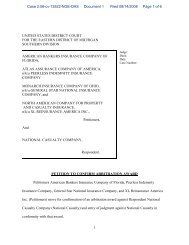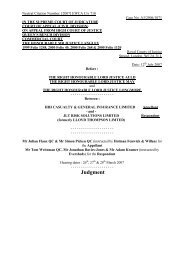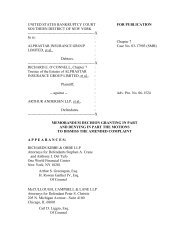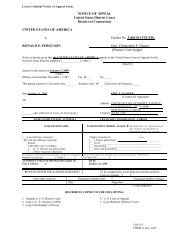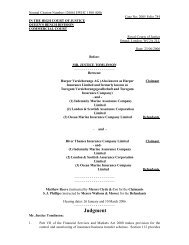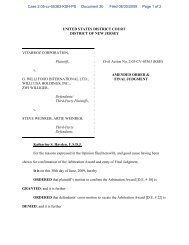Statutory Issue Paper No62R - Reinsurance Focus
Statutory Issue Paper No62R - Reinsurance Focus
Statutory Issue Paper No62R - Reinsurance Focus
You also want an ePaper? Increase the reach of your titles
YUMPU automatically turns print PDFs into web optimized ePapers that Google loves.
Property and Casualty <strong>Reinsurance</strong><br />
SSAP No. 62R<br />
Property and Casualty <strong>Reinsurance</strong><br />
SCOPE OF STATEMENT<br />
1. This statement establishes statutory accounting principles for property and casualty reinsurance.<br />
A wide range of methods for structuring reinsurance arrangements can be employed depending on the<br />
requirements of individual companies. This statement deals with the more commonly employed methods.<br />
SUMMARY CONCLUSION<br />
General<br />
2. <strong>Reinsurance</strong> is the assumption by an insurer of all or part of a risk undertaken originally by<br />
another insurer. The transaction whereby a reinsurer cedes all or part of the reinsurance it has assumed to<br />
another reinsurer is known as a retrocession.<br />
3. <strong>Reinsurance</strong> has many beneficial purposes. Among them are that it enables an insurance entity to<br />
(a) expand its capacity, (b) share large risks with other insurers, (c) spread the risk of potential<br />
catastrophes and stabilize its underwriting results, (d) finance expanding volume by sharing the financial<br />
burden of reserves, (e) withdraw from a line or class of business, and (f) reduce its net liability to amounts<br />
appropriate to its financial resources.<br />
4. <strong>Reinsurance</strong> agreements are generally classified as treaty or facultative. Treaty reinsurance refers<br />
to an arrangement involving a class or type of business written, while facultative reinsurance involves<br />
individual risks offered and accepted.<br />
5. <strong>Reinsurance</strong> coverage can be pro rata (i.e., proportional reinsurance) where the reinsurer shares a<br />
pro rata portion of the losses and premium of the ceding entity or excess of loss (i.e., non-proportional)<br />
where the reinsurer, subject to a specified limit, indemnifies the ceding entity against the amount of loss<br />
in excess of a specified retention. Most reinsurance agreements fall into one of the following categories:<br />
I. Treaty <strong>Reinsurance</strong> Contracts—Pro Rata:<br />
A. Quota Share <strong>Reinsurance</strong>—The ceding entity is indemnified against a fixed<br />
percentage of loss on each risk covered in the agreement;<br />
B. Surplus Share <strong>Reinsurance</strong>—The ceding entity establishes a retention or “line”<br />
on the risks to be covered and cedes a fraction or a multiple of that line on each<br />
policy subject to a specified maximum cession;<br />
II.<br />
Treaty <strong>Reinsurance</strong> Contracts—Excess of Loss:<br />
A. Excess Per Risk <strong>Reinsurance</strong>—The ceding entity is indemnified, subject to a<br />
specified limit, against the amount of loss in excess of a specified retention with<br />
respect to each risk covered by a treaty;<br />
B. Aggregate Excess of Loss <strong>Reinsurance</strong>—The ceding entity is indemnified against<br />
the amount by which the ceding entity’s net retained losses incurred during a<br />
specific period exceed either a predetermined dollar amount or a percentage of<br />
the entity’s subject premiums for the specific period subject to a specified limit;<br />
© 2009 National Association of Insurance Commissioners 62-3


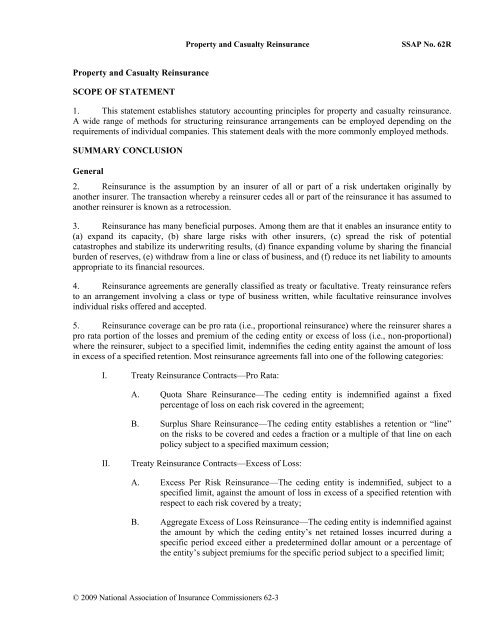
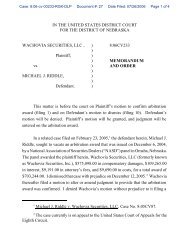
![202 Folio No 734 Neutral Citation Number: [2006] EWHC 1345 (QB ...](https://img.yumpu.com/50015000/1/184x260/202-folio-no-734-neutral-citation-number-2006-ewhc-1345-qb-.jpg?quality=85)
